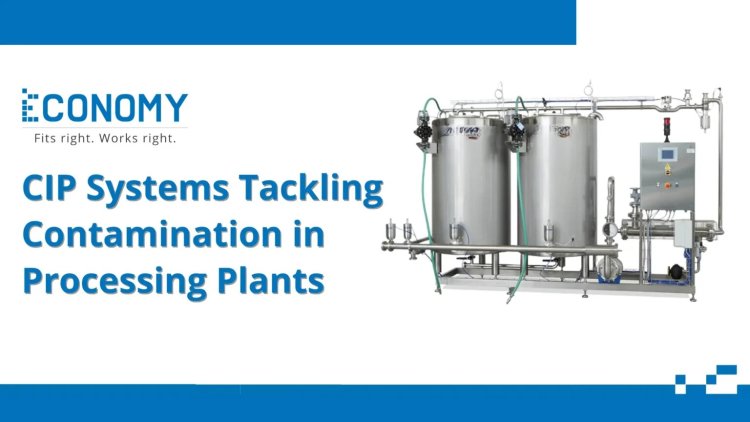The Critical Role of Clean-in-Place (CIP) Systems in Industrial Processing
Role of Clean-in-Place (CIP) Systems , Role of Clean-in-Place (CIP) Systems in Industrial Processing , Benefits of CIP Systems in Processing Plants , Clean-in-Place (CIP) Systems , CIP systems
Share this Post to earn Money ( Upto ₹100 per 1000 Views )

Industrial processing facilities, ranging from food and beverage production to pharmaceuticals and chemical manufacturing, rely heavily on maintaining stringent hygiene and operational efficiency. One of the key technologies that enable this is the Clean-in-Place (CIP) system. Role of Clean-in-Place (CIP) Systems are integral to ensuring that equipment is cleaned thoroughly without the need to disassemble the machinery, thus reducing downtime, improving safety, and ensuring product quality.
Ensuring Hygienic Standards
Maintaining hygiene is paramount in industries such as food and pharmaceuticals, where contamination can lead to significant health risks and product recalls. CIP systems are designed to meet these stringent hygiene standards by enabling thorough and consistent cleaning of internal surfaces of equipment such as pipes, vessels, and filters. This automated cleaning process uses a combination of water, chemicals, and heat to remove residues, biofilms, and microorganisms. By ensuring that every part of the equipment is cleaned to exact specifications, CIP systems help prevent cross-contamination and ensure that products meet regulatory standards.
Operational Efficiency and Downtime Reduction
Traditional cleaning methods involve disassembling equipment, which is time-consuming and labor-intensive. CIP systems eliminate the need for disassembly, allowing cleaning to occur in place. This significantly reduces the downtime required for cleaning processes, thus maximizing production time and efficiency. The automation of the CIP process means that it can be scheduled during non-production hours, ensuring that the machinery is ready for use at the start of each production cycle. Moreover, the consistent and repeatable nature of CIP cleaning reduces human error and ensures that cleaning procedures are carried out to the same high standard every time.
Cost-Effectiveness
While the initial investment in a CIP system can be substantial, the long-term savings it offers are significant. Reduced downtime translates to increased productivity and lower labor costs, as manual cleaning processes are minimized. Additionally, CIP systems are designed to be efficient in their use of water and cleaning agents, reducing the overall consumption of these resources. This efficiency not only cuts costs but also supports sustainability initiatives by minimizing waste and the environmental impact of cleaning processes. The extended lifespan of equipment due to regular and thorough cleaning also contributes to cost savings, as it reduces the frequency and cost of repairs and replacements.
Enhancing Safety
The automation and design of CIP systems enhance safety for workers by minimizing their exposure to hazardous chemicals and reducing the need for manual cleaning in confined spaces. Automated cleaning processes mean that workers do not have to dismantle equipment, reducing the risk of injury associated with manual handling and cleaning operations. Furthermore, CIP systems often incorporate safety features such as automated shutdowns in case of system faults or leaks, ensuring that any potential issues are addressed promptly without putting workers at risk.
Compliance with Regulations
Industries such as food and beverage, pharmaceuticals, and biotechnology are heavily regulated to ensure the safety and quality of products. CIP systems play a crucial role in helping these industries comply with regulatory requirements. Automated cleaning processes ensure that all parts of the equipment are cleaned to the standards required by regulatory bodies such as the FDA or ISO. Detailed records of cleaning cycles, including time, temperature, and chemical concentrations, are often automatically logged, providing verifiable documentation that can be used for audits and compliance verification.
Flexibility and Customization
CIP systems are highly versatile and can be customized to meet the specific needs of different industrial processes. Whether dealing with the intricate equipment of pharmaceutical production or the large-scale machinery of food processing, CIP systems can be tailored to deliver optimal cleaning performance. Customizable parameters such as cycle times, temperatures, and chemical concentrations allow for flexibility in addressing different types of residues and contaminants. This adaptability ensures that CIP systems can provide effective cleaning solutions across a wide range of industries and applications.
Conclusion
Clean-in-Place (CIP) systems are a cornerstone of modern industrial processing, offering numerous benefits that extend beyond mere cleanliness. By ensuring hygienic standards, enhancing operational efficiency, reducing costs, improving safety, aiding in regulatory compliance, and offering flexibility, CIP systems are indispensable in maintaining the high standards required in today’s competitive industrial landscape. Their role in ensuring product quality and safety cannot be overstated, making them a critical investment for any facility looking to optimize its cleaning processes and overall operational effectiveness.













